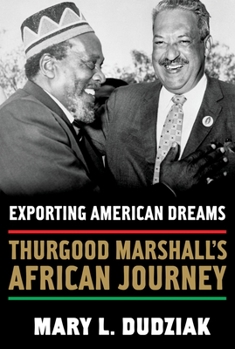Exporting American Dreams: Thurgood Marshall's African Journey
Select Format
Select Condition 
Book Overview
Thurgood Marshall became a living icon of civil rights when he argued Brown v. Board of Education before the Supreme Court in 1954. Six years later, he was at a crossroads. A rising generation of activists were making sit-ins and demonstrations rather than lawsuits the hallmark of the civil rights movement. What role, he wondered, could he now play? When in 1960 Kenyan independence leaders asked him to help write their constitution, Marshall threw...
Format:Hardcover
Language:English
ISBN:0195329015
ISBN13:9780195329018
Release Date:July 2008
Publisher:Oxford University Press
Length:272 Pages
Weight:1.55 lbs.
Dimensions:1.0" x 6.1" x 9.3"
Customer Reviews
0 rating





